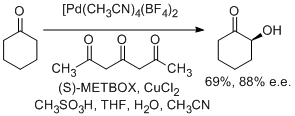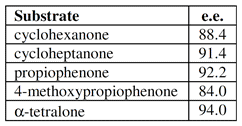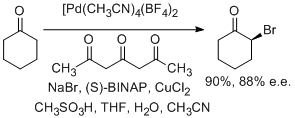Reports: AC1
48511-AC1 Palladium(II)-Catalyzed Asymmetric Synthesis of alpha-Substituted Ketones
The aim of this project is to develop new and more efficient methods of asymmetric synthesis utilizing organopalladium catalysis, both for the enantioselective introduction of new stereocenters alpha to a ketone carbonyl, and also for intramolecular chirality transfer for a molecule with existing stereocenters. Enantioselective alpha-hydroxylation of ketones is traditionally accomplished through the enantioselective oxidation of of enolate anions and enol derivatives such as enol ethers or enol stannanes. We now describe the direct enantioselective a-hydroxylation of ketones via the in-situ generated enol tautomer using a bimetallic achiral Pd(II) catalyst with triketone and chiral bidentate bridging groups with no need to form a base-generated enolate or an enol ether. In addition to cyclohexanone (90% yield, 88% e.e.), cyclopentanone, cycloheptanone, 2,5-dimethyl-4-heptanone, a-tetralone, propiophonenone and substituted propiophenone derivatives afford a-hydroxylated products in 84-94% e.e.
Asymmetric a-bromination has also been accomplished in high yield and very good e.e.'s using a bimetallic Pd(II) catalyst catalyst system.
We have extended this enantioselective a-functionalization reaction to the direct preparation of enantiomeric a-azido ketones using trimethylsilyl azide which will be extended to the synthesis of chiral vicinal amino alcohols.
Finally, we have also explored chirality transfer from chiral allylic alcohols utilizing Stille's palladium-catalyzed olefin dicarbonylation reaction for the preparation of molecules with three contiguous chiral centers. (R)-(+)-2-Cyclopenten-1-ol afforded (1S,2S,3R)-dimethyl 3-hydroxycyclopentane-1,2-dicarboxylate in 65% yield and 98% diastereoselectivity. (R)-(Z)-3-Penten-2-ol gave (2R,3R,4R)-3,4-dicarbomethoxy-2-pentanol in 80% yield and 96% diastereoselectivity, whereas the geometric isomer (E)-3-penten-2-ol afforded (2R,3R,4S)-3,4-dicarbomethoxy-2-pentanol in lower yield (45%) and diastereoselectivity (78%).
Support for this project has enabled us to achieve proof of concept of the Pd(II)-mediated direct enantioselective a-hydroxylation reaction and to explore its generality, as well as to explore the a-bromination and to discover the enantioselective a-azidation reaction. Separately, we have explored the Pd(II)-mediated diastereoselective bis-methoxycarboxylation reaction for the preparation of molecules with three contiguous chiral centers. This support by ACS-PRF has enabled one student to make significant progress toward his Ph.D. degree.









